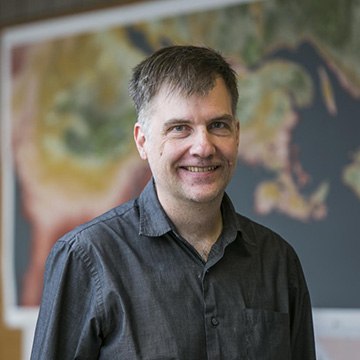
David Lee Hysell
Biography
David Hysell earned his Ph.D. from Cornell in 1992. Hysell investigates ionospheric plasma physics with a focus on plasma instabilities, ionospheric irregularities, and their effects on radio wave propagation. Communication outages caused by ionospheric irregularities are a central component of the National Space Weather Program. The instabilities of interest are found in the equatorial and auroral electrojets, in the midlatitude E region ionosphere, and in equatorial and midlatitude spread F. The research is both experimental and theoretical and has a substantial computational component. An important research tool for studying the equatorial ionosphere is the Jicamarca Radio Observatory near Lima, Peru, the world's largest radar. In the spring of 2005, Hysell became the PI for the NSF Cooperative Agreement that supports Jicamarca.
Research Interests
The ionosphere and the instabilities and irregularities that inhabit it are mainly studied with remote sensing using radar. Processing and interpreting both kinds of signals turns out to be demanding, and conventional analysis techniques are fraught with artifacts and ambiguity. Hysell's research focuses mainly on redefining the way radars are used to study the ionosphere and on improving closure between theory and experiment. As the radar techniques developed by Hysell's group are often applicable in other disciplines, including commercial and defense-related fields, this work has overtones outside aeronomy. Much of Hysell's research is conducted at the Jicamarca Radio Observatory, the world's largest radar, located outside Lima, Peru. Jicamarca is owned by the Peruvian government but funded mainly through a cooperative agreement between the National Science Foundation and Cornell University. Hysell became the PI for the cooperative agreement in 2005, helping to maintain Cornell's leadership in aeronomy, space physics, and radar remote sensing. Jicamarca provides an ideal environment for developing, prototyping, and testing new radar techniques, modes, and instrumentation. Once developed, Hysell strives to migrate new radar techniques to different geographic regions for wider application. The strategy is accomplished through the construction and deployment of portable radar systems to middle- and high-latitude sites (the Caribbean and Alaska in particular). These deployments make it possible to address a wide range of problems in aeronomy and to collaborate with different agencies and institutions. Much of the research is also suitable material for the classroom.
- Computational Fluid Dynamics
- Remote Sensing
- Earth and Atmospheric Science
- Image Analysis
- Space Science and Engineering
- Geophysical Fluid Dynamics
- Space and Planetary Sciences
- Natural Hazards
Teaching Interests
Hysell continues to teach EAS/ECE 4870, Introduction to Radar Remote Sensing, each year. Every other year, Hysell teaches EAS 4840/5840, Inverse Methods in the Natural Sciences. In between years, Hysell alternates between teaching an advanced radar course (EAS 5880) and courses on upper atmospheric physics. Hysell has also taught Introduction to Plasma Physics in ECE.
Service Interests
Outreach is conducted under the auspices of a number of research projects that involve instrument deployments to remote or underdeveloped geographic regions. These include radar stations in the Kenai Peninsula of Alaska, the island of St. Croix in the U. S. Virgin Islands, and the island state of Dominica. In each case, we endeavor to work with local universities and/or nonprofits to promote our research among undergraduate students, including underrepresented minorities, who would otherwise have little access to federally-funded research projects and major research facilities.
Selected Publications
Hysell, D. L., Bui, M. X., & Larsen, M. F. (2024). "Observations and model of subauroral sporadic E layer irregularities driven by turning shears and dynamic instability." Journal of Geophysical Research: Space Physics, 129, e2024JA033088.
Hysell, D. L., Kirchman, A., Harding, B. J., Heelis, R. A., England, S. L., Frey, H. U., & Mende, S. B. (2024). "Using ICON satellite data to forecast equatorial ionospheric instability throughout 2022." Space Weather, 22, e2023SW003817.
Hysell, D. L., & Chau, J. L. (2023). "Aperture synthesis imaging of ionospheric irregularities using time diversity MIMO radar." Radio Science, 58, e2023RS007765.
Hysell, D. L., & Rojas, E. (2023). "Modeling E-region artificial periodic inhomogeneity." Radio Science, 58, e2023RS007710. https://doi.org/10.1029/2023RS007710
Hysell, D. L., Kirchman, A., Harding, B. J., Heelis, R. A., & England, S. L. (2023). "Forecasting equatorial ionospheric convective instability with ICON satellite measurements." Space Weather, 21, e2023SW003427.
Selected Awards and Honors
- Waynick Distinguished Lecture, 2019
- Sonny Yau Excellence in Teaching Award,2006
- CEDAR Prize Lecture Award, 1999
- URSI Young Scientist Award, 1996
- Radio Science Citation for Excellence in Refereeing,1996
Education
- B.S.(Electrical & Communication Engineering),Penn State University,1987
- Ph.D.(Electrical & Communication Engineering),Cornell University,1992

